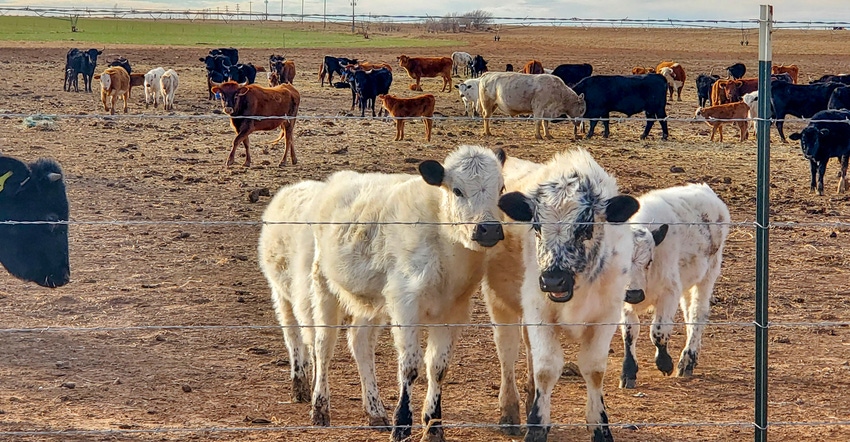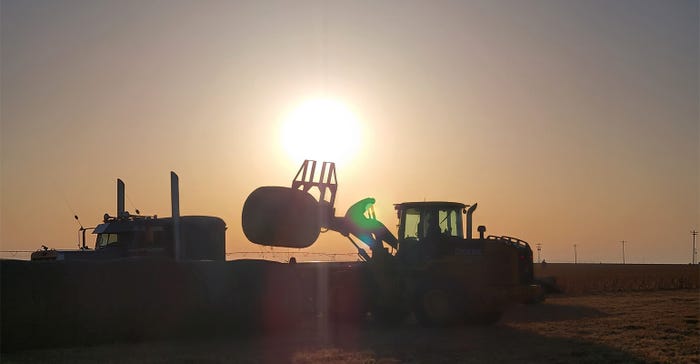
Texas cattle producers should be planning ahead and ready for scenarios that put them in good position to capitalize on a potentially strong post-drought cattle market, according to a Texas A&M AgriLife Extension Service expert.
Jason Cleere, AgriLife Extension statewide beef cattle specialist, Bryan-College Station, said cattle producers face a range of challenges and concerns as herds enter fall and winter, particularly those related to rainfall between now and spring.
Producers need to minimize costs while maximizing their herd’s productivity through these challenges because cattle market outlooks are positive, Cleere said.

According to the U.S. Drought Monitor, rainfall events in mid-August through early September reduced the percentage of the state experiencing some form of drought. More than 99% of Texas was experiencing drought on Aug. 2 compared to 78% on Sept. 13, but the percentage has climbed back to 89% as of Oct. 4.
The next drought monitor report is expected to show worsening drought conditions due to recent high temperatures and lack of rainfall, he said. The weather is expected to shift toward an El Niño pattern by spring, but the lingering La Niña patterns, which typically deliver warmer, drier weather to most of Texas, have left big question marks for producers.
Cleere said many producers still face tough decisions on their herds related to the potential costs of keeping cattle based on their operation’s stocking rates and forage stocks. Some producers are facing decisions based on low pond or stock tank water levels.
Cow and calf prices are expected to rise following widespread herd consolidation across the state due to drought, he said. Producers should be mapping out their winter based on available grazing, forage and hay stocks, as well as expected costs for supplemental feed.
The goal should be to maintain a good body condition score going into the calving seasons so that those cows will breed back to ensure a good calf crop the following year, Cleere said.
“I am optimistic about cattle numbers and future demand over the next few years,” he said. “We could be poised to be as good or better than 2014-2015, so we need to be thinking about the calf crop that will be hitting the market, and the costs of pregnancy rates and supplementation through winter. My fear is that producers will try to cut corners, and that it could impact the calf crop, fertility and the timely breed-back of cows, which would impact the next year’s calf crop.”
Be efficient rather than cut corners
Nutrition is not the place to cut corners, Cleere said.
Producers should aim for a body condition score of five for cows at calving, he said. This provides a buffer for lactating cows that will help them maintain a good condition as they recover for breeding.
Improving an operation’s efficiency when it comes to animal nutrition can be done in several ways, he said.
Cleere recommends testing hay to determine the nutritive value and what type of nutritional supplementation may be necessary. Many hay producers reduced fertilizer applications due to higher nitrogen prices this season, and hay quality could be lower than normal.
“Hay supplies are much better than they were 60 days ago, but ranchers will still be cutting it close,” he said. “It’s a great idea to test hay and let that guide the supplemental diet in an efficient way.”
Producers should also look into purchasing supplemental feed in bulk rather than by the bag or pricing other supplements with nutrition per pound in mind, he said. Total digestible nutrients per pound of feed is an important consideration because some less expensive rations may include higher amounts of fiber, which reduces the energy value of the feed.
Cleere said producers could also consider pricing troughs to reduce waste.
“Under wetter conditions, you may lose 20%-30% of cubes, and you can see a lot of nutrition go to waste on the ground,” he said. “The key is looking for efficiency in our feed management and getting the most out of every dollar you spend.”
Winter pasture could be good investment
Warm-season pastures are playing out at this point.
The investment in winter pasture, including ryegrass, could be another way to provide efficient nutrition for cattle, Cleere said. But that option is heavily dependent on whether fields receive timely rainfall events to fuel germination, establish good stands and growth if winter temperatures are mild, or during spring green up.
“There is certainly an opportunity to overseed with ryegrass, especially with the lack of thatch in many pastures,” he said. “Fertilizer prices have come down, but the question is will it rain enough to get ryegrass pastures up and keep them going through spring.”
Cleere said overseeding ryegrass in East Texas typically begins around Oct. 15, but that very few producers were preparing yet due to the moisture situation. Producers should be ready to capitalize on positive weather patterns if they are looking to establish winter pasture.
During the drought in 2011, Cleere said his operation received its first rain the week of Thanksgiving. He overseeded a sacrifice pasture that was grazed down with ryegrass the day after Thanksgiving.
“It was a mild winter, we fertilized and we had good rain, and by the end of January we had a foot of ryegrass,” he said. “That turned out to be a perfect winter for that, but it started with being ready for the rain.
“The positive is the numbers and indications that we’re seeing good market predictions,” he said. “The negatives are what we are dealing with right now with the drought and the cost of everything. We’ll need those expected prices to see profits, and so we need to be doing everything we can to control costs without sacrificing herd production.”
AgriLife Extension district reporters compiled the following summaries:

CENTRAL
Extreme drought conditions continued across the district. Soil moisture levels were very short. Rangeland and pasture conditions were very poor in nearly all areas. Stock tanks were dry, and hay was in short supply. Livestock were being liquidated. Armyworms and desert termite reports were increasing, and aphids were in pecan trees. Crops were in poor condition. Grains that were planted and emerged had dried up.
ROLLING PLAINS
Conditions were very dry across the district. Many producers were dry planting cool-season forages. Cover crops were being planted on failed cotton acres to prevent erosion during winter and spring. Fall work on cattle was underway. Wheat was planted, but fields were either emerging and dying or failing to germinate. Armyworms and fleahoppers were a problem for producers. Pastures were turning brown, and supplemental feeding of cattle continued. Cattle were in good shape.
COASTAL BEND
Temperatures were slightly cooler, but dry weather continued to reduce soil moisture levels. Field activities continued with disking, bedding up rows and spraying. Rice harvest was complete. Rain will be necessary for winter pasture planting and production. Rangeland and pasture conditions were drying out fast. Hay fields were being cut and baled. Some beef producers were feeding hay to cattle due to a lack of forage. Hay supplies were expected to be short going into winter. Cattle were in excellent condition with prices steady to higher and inventories below normal from the drought sell-off.
EAST
Drought conditions worsened, and rainfall was desperately needed. Pasture and rangeland conditions were poor to good. Subsoil and topsoil conditions were short. Ponds and creeks continued to dry up. The cotton crop was a total loss. Producers were trying to get one last cutting of hay. Livestock were doing fair to good with diet supplementation taking place. Hay supplies continued to be short. Wild pig activity slowed.
SOUTH PLAINS
Some rainfall was received. The moisture could help wheat plantings but delayed other crop harvests. Sunflower fields were almost completely dried down. Wheat fields were being scouted for pests. Cotton harvest aide applications were beginning, and bolls were opening quicker. The rain could create regrowth and weed problems that may require management. Cattle were in good condition.
PANHANDLE
Temperatures were cooler, and light rainfall was reported but not enough to improve soil moisture levels. Soil moisture levels were short. Corn harvest was close. Grain sorghum was close with many fields starting to color nicely. Winter wheat planting continued. Cotton was coming along nicely with bolls opening in some fields and harvest aides being applied in others. Rangeland and pasture conditions were poor. Ranchers were preparing to supplement cattle diets or ship for sale, and calf weaning was underway.
NORTH
Soil moisture was short for most of the district, and conditions continued to decline. Some producers were dry planting wheat and oats. Many ponds and stock tanks were drying up, and hay supplies were still critically low. Hay was being cut from roadsides and other locations. Grasshopper populations were still high.
FAR WEST
Colder temperatures dropped into the mid-80s during the day and mid-50s overnight. Showers moved through the district with totals ranging from trace amounts to 1.3 inches. A large hailstorm and flash flooding hit Pecos County with an accumulation of a foot or more of dime- sized hail reported. The hail caused damage to trees, shrubs and grass. Some roads washed out and buildings were flooded. Cotton harvest began, and yields were predictably poor. Wheat planting continued. Pastures remained bare, so all livestock were being fed.
WEST CENTRAL
The weather was dry with warm to hot afternoons and cool nights. Some areas received decent rain, and farmers were trying to plant more wheat. Some producers were dry planting wheat and hoping for moisture. Some late-season hay baling occurred. The pecan harvest was about two weeks behind normal. Pastures were dry, and livestock owners were beginning to sell off more livestock after the brief slowdown.
SOUTHWEST
Drought conditions continued. Wheat and oat plantings were complete. Dry conditions were impacting germination of the most recently planted wheat. Wildfire risks remained high. Cotton harvest appeared to be complete. Daytime temperatures were cooler with low humidity. Some winter small grains were being planted. Pastures and rangeland continued to decline while producers relied on supplemental feed for livestock and continued to cull animals.
SOUTH
Northern parts of the district reported very short to short soil moisture levels while eastern, western and southern areas were mostly short to adequate. Weather remained dry with cooler temperatures. Cotton harvest was complete in most areas and almost complete in others. Cotton bales were being moved to gins. Peanuts were maturing under irrigation. Citrus and sugarcane were being irrigated as well. Dirt work and plastic mulch placement continued in preparation for strawberry planting. Onions and other winter vegetables were being planted. Producers continued fieldwork preparations for row crops. Hay producers continued to cut and bale, but most summer forages were finished for the season with most producers reported just one cutting. Rangeland and pasture conditions were declining, and diet supplementation was necessary for all livestock and beef cattle operations. Reports of good pasture conditions were scattered, and a few areas reported continued improvement. Cattle prices were steady at some markets and dipped at others, and herd culling slowed. Cattle body conditions were good. Fields were being prepared for oats and winter wheat fields and food plots, but few plantings were in so far due to fall armyworm concerns. Pecan harvests were expected to be average. Hunters were supplementing deer with corn, protein and cotton seed. Falcon Lake water levels continued to improve.
Source: Texas A&M AgriLife Today
About the Author(s)
You May Also Like




